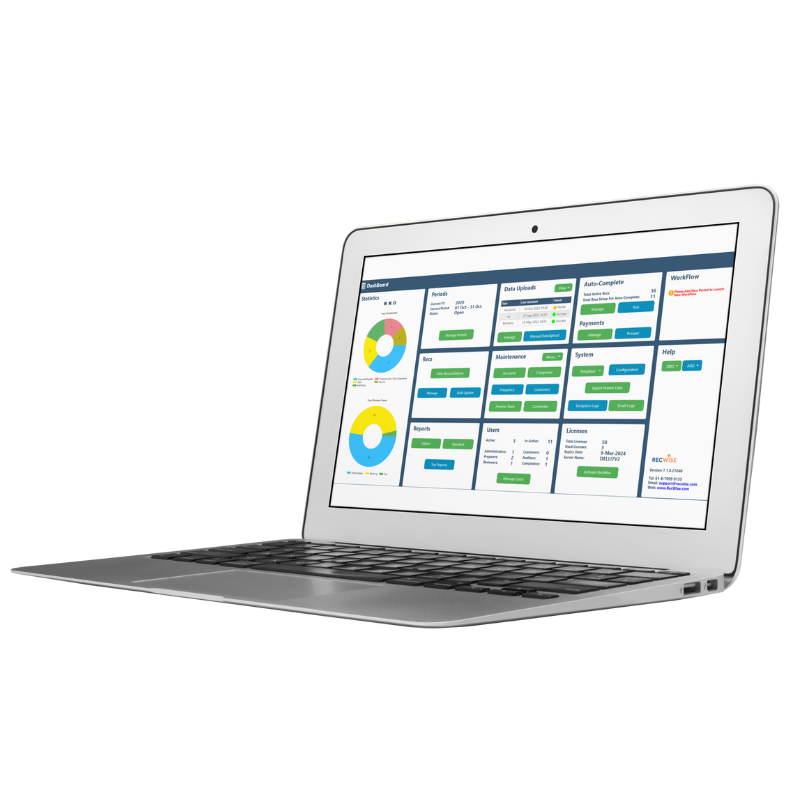Manage Your Financial Close With Software That Doesn’t Let You Down
Don’t sweat the small stuff! RecWise is designed for accountants by accountants; the single reconciliation solution to improve the month-end close and ensure fuss-free audits.
Trusted by these industry experts






































Month End Made Easy.
Improving the visibility of the reconciliation process to aid in the inevitable audit and being able to rely on the information for the financial statements is a goal for all companies. Regardless of the industry the goal here is to produce accurate, trustworthy information.

“As a long time user, I recommend RecWise as a value for money proposition to streamline the balance sheet reconciliation process.”
Close Quicker, Resolve Faster.
Having a reliable solution that can achieve your goals as well as improve the robustness of the month-end close is why you choose RecWise. A familiar interface reduces the risk of implementation failure, easier uptake by users and easily managed by your team.
How RecWise Works

Tracking Balance Changes
RecWise tracks monthly balance movements rather than individual transactions. For example, if your balance changes from $20,000 to $30,000, it automatically identifies the $10,000 difference.

Breaking Down the Balance
The Preparer investigates details in the ERP system. For instance, with Fixed Assets, you can identify and add new purchases to the reconciliation balance, such as a $10,000 equipment purchase.

Catching Errors
Record and manage unexpected transactions as reconciling items. The system ages items automatically, ensuring they're actioned and reportable.

Balancing the Books
After noting and fixing errors, ensure the total matches your ERP balance. Attach supporting documents and comments for a complete audit trail.
“We haven’t encountered an audit failure in two decades.”
RecWise ensures that the month-end balances companies report are accurate and verifiable. It helps users catch and correct mistakes, making financial statements reliable for auditors and stakeholders.
Designed by accountants, for accountants
There are alternative reconciliation tools in the marketplace, however not only have we doubled down on our niche and specialise in this support, but our client experience is also second to none. Here is what you can expect from partnering with us.
Quick deployment
With deployment in as little as two weeks, our solution is easy to implement and simple to use, enabling your team to perform at their best immediately.
No outages or downtime
Built with reliability at its core, RecWise ensures no outages or downtime, operates on your infrastructure or private cloud environment, and offers unparalleled local support with resolutions in as little as one day, regardless of geography.
Take back your time
Reduce your workload and increase productivity with greater transparency and integrity. With a clean dashboard, you will have a clear overview of the status of each reconciliation, facilitating easy monitoring and management. Set up automated rules to increase efficiency, save time, and minimise errors in your financial reports.
Australian support
Whether you need agile product improvements or direct accountability from local Australian account managers, RecWise is your partner in streamlined and effective reconciliations. If you’re international, we support you the same way quickly and efficiently.
Positive ROI
As the most affordable reconciliation software with a proven track record, RecWise offers a lower total cost of ownership and delivers a positive ROI within months by reducing accounting time and cutting costs associated with printing, storage, and manual processes.
No training needed
RecWise minimises messaging clutter, requires no training for auditors, and is backed by a long-term, trusted user base.
A familiar interface that works the way you are used to it. Keeping it super simple it’s stupid. KISSS.
Ditch the month-end frenzy
Cut down audit time and effectively mitigate risks associated with reconciliations. RecWise sets itself apart by providing a robust compliance structure specifically designed and seamlessly collaborating with your ERP system, allowing for a smoother audit when the time comes.
We’ll cut through the chaos with this process
Experience RecWise firsthand
Customised to your needs
Complete Control
Superior Support
Frequently Asked Questions
Is RecWise SaaS?
No, however, it is on a cloud, and whilst this may mean there are some additional cloud costs, these can be negotiated with your provider and gain the economies of scale for your business not ours.
How secure is it?
Security is a major concern for all companies, especially your financial data. By opting for our on-premise product, you can eliminate the uncertainty of supplier breaches and potential non-disclosure. Our security is seamlessly integrated with your Active Directory service. We also do not store any Personal Identifiable Information (PII). Additionally, a small add-on service can be purchased if you use OKTA as a security provider. We also provide out-of-the-box two-factor authentication.
Is RecWise frequently updated?
Upgrades are provided as part of the annual subscription. We release upgrades generally half yearly in April and October. These are recommended to be implemented; however, you do have the choice not to update. It is important to note that we don’t just release an upgrade, we work alongside you to choose a suitable time and a suitable path to follow.
As browsers, such as Google’s Chrome and Microsoft’s Edge, can update and change sporadically without notice, it is always wise to upgrade our software annually to ensure cohesion.
We also provide a free test environment to all new and existing customers. This allows customers to trial new functionality and observe how they’re able to improve the process and run mock month-ends. These tests can ensure customers are happy with the functionality of the program before upgrading to Production.
Will training be provided?
Training is simple, we collaborate with you to select a suitable day and time. Training is provided by a Webinar typically provided through Microsoft Teams.
Supporting documentation also is embedded in the application and allows for users to reference key points or browse at a suitable pace.
Further support can be reached at support@recwise.com.
If your support is urgent we always recommend picking up the phone and calling, simple, fast and effective.
How long does it take to set up?
Our dedicated team will implement global and local solutions efficiently and within a timeframe that sees you operational and reaping the benefits within 10 business days when all the required data is available.
How does the autocomplete function work?
Utilising one of the nearly twenty autocomplete rules can assist you in working smarter and not harder. Each reconciliation can have an individual rule applied. What this means is that if you have a static balance for a reconciliation, you can simply add in a suitable rule. If the rule is met, then the preparer of the reconciliation along with the reviewer, and optional approver, don’t need to action the reconciliation, it’s done saving you time and more importantly effort.
However, we don’t want the users to be complacent so you can also add in an interruption in quieter periods should you want the users to complete a reconciliation anyway.
Autocomplete rules for some customers make up to 95%+ of their reconciliations done and dusted by running the rules and not having to have valuable resources committed to mundane reconciliations.
Will there be ongoing support?
The application is supported throughout its lifecycle with some customers still choosing to use older versions as they know the software is built to perform. If you have a question or an urgent issue that needs attention, we always recommend you call us directly.
If it can wait 24 hours, then we suggest an email at support@recwise.com, and we will get back to you in a timely manner to resolve the issue. We sometimes sleep.
Ready to maintain financial integrity with confidence?
By enabling trust in the numbers, we safeguard shareholder confidence, support market readiness, and help protect the value of your business. With RecWise, you can be assured that your financial processes are transparent, efficient, and always audit-ready.
Book Your RecWise Demo
Ready to see how RecWise can transform your reconciliation process?
See how RecWise can streamline your month-end reconciliation process. Complete the form below and our Australian team will contact you within one business day to arrange your demonstration.

